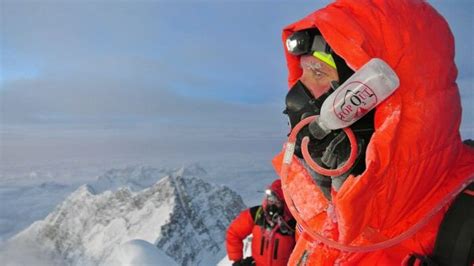
Everest climbers are increasingly relying on hypoxic tents to pre-acclimatize to extreme altitudes, a strategy credited with aiding record-breaking ascents of the world’s highest peak. These specialized tents simulate the oxygen-deprived environment found at Everest’s summit, allowing climbers to prepare their bodies for the harsh conditions they will face during their expedition.
Hypoxic Tents: A Pre-Acclimatization Tool
Hypoxic tents, also known as altitude simulation systems, are enclosed spaces where the oxygen concentration can be reduced to mimic the air density found at high altitudes. By spending time in these tents before their ascent, climbers can trigger physiological adaptations that enhance their ability to perform in oxygen-scarce environments. This pre-acclimatization process can significantly reduce the risk of altitude sickness, a common and potentially life-threatening condition that affects many Everest climbers.
According to the Yahoo News article, the use of hypoxic tents is becoming increasingly popular among Everest climbers aiming to break records and improve their chances of reaching the summit safely. The technology allows climbers to gradually adjust to the thin air of Everest in the comfort of their own homes or training facilities, reducing the time needed for acclimatization on the mountain itself. This can lead to faster ascents, reduced exposure to hazards, and improved overall performance.
The Science Behind Hypoxic Pre-Acclimatization
The human body responds to reduced oxygen levels by producing more red blood cells, which carry oxygen from the lungs to the tissues. This process, known as erythropoiesis, increases the body’s oxygen-carrying capacity and helps to compensate for the lower oxygen saturation at high altitudes. Hypoxic training also stimulates the production of a hormone called erythropoietin (EPO), which plays a key role in red blood cell production.
“When you are exposed to low oxygen levels, your body starts to produce more red blood cells to compensate,” explains Dr. Jim Loeppky, an exercise physiologist at the University of New Mexico, in an interview with Yahoo News. “This process takes time, so pre-acclimatization with hypoxic tents can give climbers a significant advantage.”
In addition to increasing red blood cell production, hypoxic training can also improve the efficiency of oxygen delivery to the muscles and tissues. This is achieved through changes in the microcirculation, which is the network of small blood vessels that supply oxygen to the cells. Hypoxic exposure can stimulate the growth of new capillaries, increasing the surface area for oxygen exchange and improving the overall oxygen supply to the body.
Furthermore, hypoxic training can enhance the body’s ability to utilize oxygen more efficiently at the cellular level. This involves changes in the mitochondria, the powerhouses of the cells, which are responsible for converting oxygen into energy. Hypoxic exposure can stimulate the production of more mitochondria and improve their efficiency in utilizing oxygen, leading to increased energy production and improved performance at high altitudes.
Benefits of Using Hypoxic Tents
The use of hypoxic tents offers several potential benefits for Everest climbers:
- Reduced risk of altitude sickness: Pre-acclimatization with hypoxic tents can help to prevent or reduce the severity of altitude sickness, which can range from mild headaches and nausea to life-threatening conditions such as high-altitude pulmonary edema (HAPE) and high-altitude cerebral edema (HACE).
- Faster acclimatization on the mountain: By pre-acclimatizing at home, climbers can reduce the amount of time they need to spend acclimatizing on Everest, allowing them to reach the summit faster and with less risk of exposure to hazards.
- Improved performance: Hypoxic training can improve the body’s oxygen-carrying capacity and efficiency, leading to increased energy production and improved physical performance at high altitudes.
- Reduced exposure to hazards: Spending less time on the mountain reduces the risk of exposure to hazards such as avalanches, falls, and extreme weather conditions.
- Increased chances of success: By improving their physiological preparedness, climbers can increase their chances of successfully reaching the summit of Everest and returning safely.
Risks and Considerations
While hypoxic tents offer several potential benefits, it is important to be aware of the potential risks and considerations associated with their use:
- Cost: Hypoxic tents and training programs can be expensive, requiring a significant investment of money and time.
- Medical supervision: It is important to consult with a medical professional before starting hypoxic training, especially for individuals with pre-existing health conditions. Medical supervision is recommended to monitor the body’s response to hypoxia and to adjust the training protocol as needed.
- Potential side effects: Some individuals may experience side effects from hypoxic training, such as headaches, fatigue, and nausea. These side effects are usually mild and temporary, but it is important to be aware of them and to stop training if they become severe.
- No guarantee of success: While hypoxic training can improve physiological preparedness for high-altitude climbing, it is not a guarantee of success. Many other factors, such as weather conditions, physical fitness, and mental fortitude, also play a role in the outcome of an Everest expedition.
- Over-reliance on technology: It is important to avoid over-reliance on technology and to maintain a healthy respect for the challenges and risks of high-altitude climbing. Hypoxic training should be viewed as a tool to enhance preparedness, not as a substitute for proper training, experience, and judgment.
Examples of Record-Breaking Climbers Using Hypoxic Tents
The Yahoo News article highlights several examples of Everest climbers who have used hypoxic tents to prepare for their expeditions and achieve record-breaking ascents. These climbers credit hypoxic training with helping them to acclimatize faster, perform better, and reduce their risk of altitude sickness.
One example is Nirmal Purja, a Nepalese mountaineer who broke the world record for the fastest ascent of all 14 eight-thousand-meter peaks. Purja used hypoxic tents extensively during his training for the “Project Possible” expedition, which saw him summit all 14 peaks in just six months and six days. He credits hypoxic training with helping him to acclimatize quickly to the extreme altitudes and to maintain his physical performance throughout the expedition.
Another example is Adrian Ballinger, an American mountaineer who has summited Everest multiple times without using supplemental oxygen. Ballinger uses hypoxic tents regularly to prepare for his high-altitude expeditions. He believes that hypoxic training helps him to improve his body’s ability to function in low-oxygen environments and to reduce his reliance on supplemental oxygen.
Ethical Considerations
The use of hypoxic tents and other altitude simulation technologies raises ethical questions about fairness and access in mountaineering. Some argue that these technologies give an unfair advantage to climbers who can afford them, creating a disparity between those who have access to the latest advancements and those who do not.
Others argue that hypoxic training is simply a tool that climbers can use to improve their preparedness and reduce their risk of injury or death. They believe that it is up to each individual climber to decide whether or not to use these technologies and that it is not the role of governing bodies to regulate their use.
Conclusion
Hypoxic tents are becoming increasingly popular among Everest climbers as a means of pre-acclimatizing to the extreme altitudes of the mountain. These specialized tents simulate the oxygen-deprived environment found at Everest’s summit, allowing climbers to prepare their bodies for the harsh conditions they will face during their expedition.
While hypoxic tents offer several potential benefits, it is important to be aware of the potential risks and considerations associated with their use. Climbers should consult with a medical professional before starting hypoxic training and should be aware of the potential side effects.
Ultimately, the decision of whether or not to use hypoxic tents is a personal one. Climbers should weigh the potential benefits and risks and make a decision that is right for them. However, it is clear that hypoxic training is becoming an increasingly important tool for Everest climbers seeking to improve their performance and reduce their risk of altitude sickness. The future of high-altitude mountaineering may very well see these technologies become even more integrated into training regimens, further pushing the boundaries of human endurance.
Frequently Asked Questions (FAQ)
-
What is a hypoxic tent, and how does it work?
A hypoxic tent, also called an altitude simulation system, is an enclosed space where the oxygen concentration is reduced to mimic the air density at high altitudes. By reducing the oxygen level, typically using a nitrogen generator, the tent simulates conditions found at elevations like Mount Everest. Climbers spend time in these tents to trigger physiological adaptations, like increased red blood cell production, which help their bodies function better in low-oxygen environments. According to Dr. Jim Loeppky, “When you are exposed to low oxygen levels, your body starts to produce more red blood cells to compensate.”
-
What are the main benefits of using a hypoxic tent before climbing Everest?
The main benefits include a reduced risk of altitude sickness, faster acclimatization on the mountain, improved physical performance at high altitudes, reduced exposure to hazards like avalanches and extreme weather, and ultimately, an increased chance of successfully reaching the summit. Pre-acclimatization in a hypoxic tent allows climbers to begin adapting to lower oxygen levels before even arriving at base camp, potentially shortening the time spent acclimatizing on the mountain itself. This reduces the cumulative risk associated with high-altitude exposure.
-
Are there any risks or side effects associated with using hypoxic tents?
Yes, there are potential risks and side effects. These can include headaches, fatigue, nausea, and in rare cases, more serious complications. It’s essential to consult with a medical professional before starting hypoxic training, especially for individuals with pre-existing health conditions. Medical supervision is recommended to monitor the body’s response to the simulated altitude and adjust the training accordingly. The cost of the tents and training programs can also be a barrier for some climbers.
-
Can anyone use a hypoxic tent, or are there specific qualifications or requirements?
While anyone could theoretically use a hypoxic tent, it is strongly recommended that individuals undergo a medical evaluation before beginning any hypoxic training program. This evaluation should assess their overall health and identify any potential contraindications or risks. People with pre-existing heart conditions, lung problems, or other medical issues should exercise extreme caution and seek guidance from a physician experienced in altitude medicine.
-
How long should a climber spend in a hypoxic tent before attempting to climb Everest?
The duration and intensity of hypoxic training vary depending on the individual climber’s physiology, training history, and goals. A typical program might involve spending several hours per day in the tent for several weeks or even months before the expedition. Climbers often start at a simulated altitude of around 8,000 to 10,000 feet and gradually increase the altitude over time, mimicking the gradual ascent they would experience on the mountain. A personalized training plan, developed with the guidance of a qualified coach or medical professional, is essential for optimizing the benefits and minimizing the risks of hypoxic training.
-
How much does a hypoxic tent cost and what is the total cost to acclimatize at home versus on the mountain? Hypoxic tents vary widely in price. Basic models suitable for home use might start around $2,000 to $5,000, while more sophisticated, commercially-graded systems can cost upwards of $10,000 to $20,000. The total cost of acclimatizing at home versus on the mountain is difficult to precisely quantify, as it depends on various factors. These include the length of the expedition, the number of days spent acclimatizing at different altitudes, the use of supplemental oxygen, and the cost of permits, guides, and logistical support. However, while the initial investment in a hypoxic tent can be significant, it might potentially reduce the overall expedition expenses by shortening the time spent acclimatizing on the mountain and decreasing the need for supplemental oxygen, which can be costly. Moreover, acclimatizing at home could mitigate health risks associated with prolonged exposure to high altitude.
-
Does pre-acclimatization with hypoxic tents completely eliminate the risk of altitude sickness on Everest?
No, pre-acclimatization with hypoxic tents significantly reduces the risk of altitude sickness but does not eliminate it entirely. Altitude sickness is a complex condition that can be influenced by various factors, including individual physiology, ascent rate, hydration, nutrition, and overall health. While hypoxic training can improve the body’s ability to function in low-oxygen environments, it does not guarantee immunity to altitude sickness. Climbers should still be vigilant for symptoms of altitude sickness during their ascent and take appropriate measures, such as descending to a lower altitude, if necessary.
-
Are there any alternatives to hypoxic tents for pre-acclimatizing to high altitudes?
Yes, there are several alternatives to hypoxic tents for pre-acclimatizing to high altitudes. One option is to spend time at moderate altitudes (e.g., 8,000 to 10,000 feet) for several weeks or months before the expedition. This allows the body to gradually adapt to the lower oxygen levels. Another alternative is intermittent hypoxic training, which involves alternating between periods of low and normal oxygen levels. This can be done using a mask and a hypoxic generator. Some climbers also use altitude simulation chambers, which are larger, more sophisticated versions of hypoxic tents. Each of these methods has its own advantages and disadvantages, and the best approach depends on the individual climber’s needs and resources.
-
How does hypoxic training affect athletic performance at sea level after the Everest climb is completed?
Hypoxic training can have positive effects on athletic performance at sea level. Studies have shown that it can improve endurance, speed, and power in some athletes. This is likely due to the physiological adaptations that occur during hypoxic training, such as increased red blood cell production, improved oxygen delivery to the muscles, and enhanced mitochondrial function. However, the effects of hypoxic training on sea-level performance can vary depending on the individual and the specific training protocol used. Some athletes may experience significant improvements, while others may see little or no benefit.
-
Are there any regulations or guidelines governing the use of hypoxic tents in mountaineering?
Currently, there are no specific international regulations or guidelines governing the use of hypoxic tents in mountaineering. The use of these technologies is generally left to the discretion of individual climbers and their guides. However, some mountaineering organizations and governing bodies may have their own recommendations or policies regarding the use of altitude simulation technologies. It is important for climbers to be aware of any such guidelines and to use hypoxic tents responsibly and ethically. The ethics of using advanced technologies remains a point of contention in the mountaineering community.
-
What are the long-term health effects of repeated hypoxic exposure during training and climbing?
The long-term health effects of repeated hypoxic exposure are still being studied, but there is a potential for both benefits and risks. Potential benefits could include improved cardiovascular health and increased resilience to stress. Risks could involve increased oxidative stress, potential neurological changes, and a possible increased risk of certain cardiovascular conditions over time. More research is needed to fully understand the long-term effects of repeated hypoxic exposure, and climbers should consult with medical professionals to assess their individual risk factors.
- How do hypoxic tents compare to altitude acclimatization drugs like Diamox (acetazolamide)?
Hypoxic tents and Diamox address altitude acclimatization in different ways. Hypoxic tents stimulate the body’s natural acclimatization processes over time, primarily by increasing red blood cell production. Diamox, on the other hand, is a medication that helps the body to adapt to altitude more quickly by increasing the excretion of bicarbonate, which helps to balance the blood’s pH. Diamox can alleviate some of the symptoms of altitude sickness, but it doesn’t provide the same long-term physiological adaptations as hypoxic training. Some climbers use both hypoxic tents for pre-acclimatization and Diamox as a backup for managing symptoms on the mountain. It’s crucial to consult with a physician to determine the best approach.
- Do hypoxic tents work the same for everyone, or are there individual variations in response?
Hypoxic tents do not work the same for everyone. Individual responses to hypoxic training can vary significantly based on factors such as genetics, age, baseline fitness level, pre-existing health conditions, and adherence to the training protocol. Some individuals may experience rapid and significant improvements in their altitude tolerance, while others may see little or no benefit. It’s important to monitor individual responses closely and adjust the training program accordingly.
- How is the altitude inside a hypoxic tent controlled and monitored?
The altitude inside a hypoxic tent is controlled by regulating the oxygen concentration. This is typically achieved using a nitrogen generator, which removes oxygen from the air and replaces it with nitrogen. The oxygen concentration is monitored using an oxygen sensor, and the level can be adjusted to simulate different altitudes. High-end systems incorporate feedback loops to maintain the oxygen concentration within a specified range. Users should regularly verify the tent’s functionality with calibrated sensors and be aware of potential equipment malfunctions.
- Besides Everest, what other applications are there for hypoxic training and altitude simulation?
Besides Everest and high-altitude mountaineering, hypoxic training has various other applications. It is used by endurance athletes to improve their performance at sea level, by military personnel to prepare for operations in high-altitude environments, and by researchers studying the physiological effects of hypoxia. Hypoxic training is also being explored as a potential therapy for certain medical conditions, such as sleep apnea and chronic obstructive pulmonary disease (COPD). The technology also helps in research simulating extreme conditions and studying human physiological responses.
- How do weather fluctuations on Everest affect the effectiveness of pre-acclimatization achieved via hypoxic tents?
While hypoxic tents offer pre-acclimatization, they cannot replicate all the challenges posed by Everest’s weather. Climbers accustomed to controlled hypoxic environments may still face unexpected conditions such as rapid temperature drops, high winds, and intense solar radiation. The physiological benefits gained from hypoxic tents contribute to an improved baseline, making the body more resilient to stress. Still, climbers should ensure they are well-versed in handling extreme weather conditions to prevent cold-related injuries like frostbite and hypothermia.
- What role do guides and Sherpas play in facilitating the use of hypoxic tents for climbers preparing for Everest?
Guides and Sherpas often assist climbers in understanding and utilizing hypoxic tents correctly. They may offer guidance on setting up the tents, monitoring oxygen levels, and adjusting training schedules. Additionally, their experience with high-altitude environments provides invaluable insights into how pre-acclimatization can be optimally integrated with on-mountain acclimatization strategies. Sherpas also help transport the equipment required to establish hypoxic environments.
- How does the use of hypoxic tents impact the traditional Sherpa acclimatization process on Everest?
The traditional Sherpa acclimatization process often involves gradual ascents and descents between base camp and higher camps, allowing their bodies to naturally adapt to the decreasing oxygen levels. While Sherpas are genetically adapted to high altitudes, they still require acclimatization to reach Everest’s summit safely. Hypoxic tents, if used by Sherpas, can provide an additional boost to their acclimatization, potentially enabling them to perform their duties more efficiently and safely. However, it’s essential that the tents complement, rather than replace, the traditional acclimatization methods.
- What are the best practices for incorporating hypoxic tent training into a comprehensive Everest climbing preparation plan?
Best practices for incorporating hypoxic tent training include starting the training several weeks or months before the expedition. Begin with low simulated altitudes and gradually increase the altitude over time. Monitor your body’s response closely and adjust the training plan accordingly. Consult with a medical professional or experienced coach. Combine hypoxic training with other important aspects of Everest climbing preparation, such as physical fitness training, nutrition planning, and mental preparation. The integration needs to be carefully managed to yield the most benefit without overstressing the body.
- Can hypoxic tents be used to simulate the environmental conditions of other high-altitude mountains beyond Everest? Yes, hypoxic tents can be used to simulate the environmental conditions of other high-altitude mountains beyond Everest. By adjusting the oxygen concentration inside the tent, you can mimic the air density at various elevations. This makes hypoxic tents a versatile tool for training and pre-acclimatizing for any mountain with a high-altitude summit. The adaptability of the tents broadens their applications across various high-altitude pursuits, offering consistent simulation opportunities irrespective of the intended peak.









